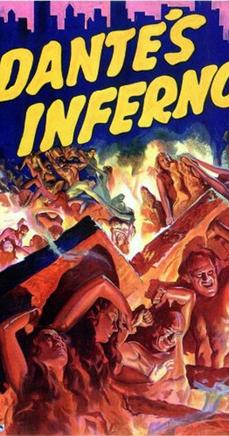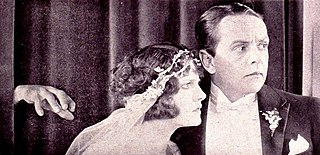The year 1915 in film involved some significant events.
Dante's Inferno is the first part of Dante Alighieri's 14th-century epic poem Divine Comedy.

Dante's Inferno is a 1935 American drama horror film starring Spencer Tracy and loosely based on Dante Alighieri's Divine Comedy. The film remains primarily remembered for a 10-minute depiction of hell realised by director Harry Lachman, himself an established Post-Impressionist painter. This was Fox Film Corporation's last film to be produced under the Fox Studios banner before the company merged with Twentieth Century Pictures to form 20th Century-Fox Film Corporation.

In film, nudity may be either graphic or suggestive, such as when a person appears to be naked but is covered by a sheet. Since the birth of film, depictions of any form of sexuality have been controversial, and in the case of most nude scenes, had to be justified as part of the story.

L'Inferno is a 1911 Italian silent film, loosely adapted from Inferno, the first canticle of Dante Alighieri's Divine Comedy. L'Inferno took over three years to make, and was the first full-length Italian feature film.

Pauline Starke was an American silent-film actress.

The Divine Comedy has been a source of inspiration for artists, musicians, and authors since its appearance in the late 13th and early 14th centuries. Works are included here if they have been described by scholars as relating substantially in their structure or content to the Divine Comedy.

Niles Eugene Welch was an American performer on Broadway, and a leading man in a number of silent and early talking motion pictures from the early 1910s through the 1930s.

The Mysterious Island is a 1929 American sound part-talkie science fiction film directed by Lucien Hubbard, based on Jules Verne's 1874 novel L'Île mystérieuse. The film was photographed largely in two-color Technicolor. In addition to sequences with audible dialogue or talking sequences, the film features a synchronized musical score and sound effects along with English intertitles. The sound was recorded via the Western Electric sound-on-film process. The film was released by Metro-Goldwyn-Mayer.

Noble Johnson, later known as Mark Noble, was an American actor and film producer. He appeared in films such as The Mummy (1932), The Most Dangerous Game (1932), King Kong (1933) and Son of Kong (1933).
Forbidden Paradise is a 1924 American silent drama film, directed by Ernst Lubitsch, produced by Famous Players–Lasky, and distributed by Paramount Pictures. The film is based on a 1922 Broadway play, The Czarina, by Edward Sheldon, who adapted the Hungarian-language book by Melchior Lengyel and Lajos Bíró. The play starred Doris Keane, in one of her last stage roles, as Catherine the Great. Basil Rathbone costarred with Keane. The film stars Pola Negri as Catherine the Great and Rod La Rocque in the Rathbone role. Clark Gable makes his second appearance on film.

William Edward "Bud" Jamison was an American film actor. He appeared in 450 films between 1915 and 1944, notably appearing in many shorts with The Three Stooges as a foil.

Haunted Spooks is a 1920 American silent Southern Gothic comedy horror film, produced and co-directed by Hal Roach, starring Harold Lloyd and Mildred Davis.

Ralph Percy Lewis was an American actor of the silent film era.

George Henry Irving was an American film actor and director.

The Arizona Express is a 1924 American silent crime drama film directed by Tom Buckingham and starring Pauline Starke and Evelyn Brent.

The Folly of Vanity is a 1924 American silent drama film codirected by Maurice Elvey and Henry Otto and starring Billie Dove and Betty Blythe. It was produced and distributed by the Fox Film Corporation. The film is divided into two sections, the modern part which was directed by Elvey and the underwater fantasy section directed by Otto.

Honesty – The Best Policy is a 1926 American silent comedy film directed by Chester Bennett and Albert Ray and starring Rockliffe Fellowes, Pauline Starke and Johnnie Walker.

Troubles of a Bride is a 1924 American silent comedy film directed by Tom Buckingham and written by John Stone and Tom Buckingham. The film stars Robert Agnew, Mildred June, Alan Hale Sr., Bruce Covington, Dolores Rousse, and Heinie Conklin. The film was released on November 30, 1924, by the Fox Film Corporation.

Italian: Novelle licenziose di vergini vogliose, lit. 'Licentious Tales of Lusty Virgins', is a 1973 Italian decamerotic comedy film lensed and directed for the most part by Joe D'Amato. The story and screenplay were written by D'Amato and producer Diego Spataro.

















